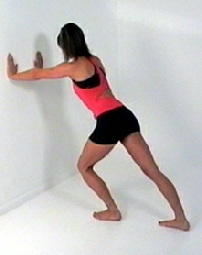












Gentle Running and Living
by Dr Patrick Salmon, PharmD, PhD
Member of the Barefoot Runners Society
Founding Member of the Tarahumara Spirit



Be gentle
to yourself
and others!
“Life is hard enough to add extra suffering to it”. We propose here a way to build a stronger, healthier and happier self through gentle running. Then, this “ascetic hedonism” can be translated into several aspects of life, to humbly contribute to a better world.

You can help your fellow humans and the world in general by sharing this site and its links.
You can join me at this email: drbarefootpat@gmail.com

Version française (en construction) à ce lien.


My blog
This page is under constant construction since I update it regularly with feedbacks from my students of all levels (beginners to below-3h-marathoners.
So, come back often for updates
Transition to Natural Running Style while still running lots of miles
What you need first is a pair of transition shoes
- These shoes allow heel-striking but favor midfoot/forefoot landing.
- They have a low drop, i.e. the heel is only 3-4 mm above the front of the shoe, and thus, you are NOT wearing high-heel shoes that make it hard NOT to touch the ground with your heel first.
- They have some cushioning to allow heel-strike without too much impact. Much like “traditional shoes”.
- The cushioning is not too big so your feet can re-learn to feel and read the ground and adjust accordingly.
- I recommend 2 shoes for this, the Newton Gravity and the Brooks Pure Flow (or other models of the Connect Me product line).


One you have these shoes
- STEP1
- Go running as you do normally.
- For the last 10% of your run, but 1 km max, start running actively, using your forefoot only.
- For this, you will need to apply all the principles of Natural Running:
- Make smaller strides
- Land as smoothly, as silently as possible.
- Increase your cadence
- Land under your center of mass
- Adopt the Spanish Dancer posture, as described in the other pages.
- Lift your foot/leg as soon as you touch the ground, by pulling your knee up (never push on the ground with your foot to move forward)
- At the end of your run, do the stretchings described in the specific page. These stretchings are essential since you are putting a lot of stress in your calf muscle and Achilles tendon, and you will soon discover that they are atrophied.
- The next day, do not run but feel your calves and Achilles. It is very likely that you will feel very sore and may even have trouble climbing down stairs. Be gentle to yourself.
- Once the soreness/tightness of the calves is gone and the Achilles tendons are cool again (it could take 2 or 3 days), resume your usual run with the same load of Natural Running (10% of the run or 1 km max). Do the same stretchings after each run.
- Do this routine until you do not feel any muscle soreness in your calves or any tendonitis in your Achilles in the days following the run. This can take several weeks. Be patient and humble, you are constructing powerful legs for the rest of your life.
- STEP2
- When you reach the point where there is no soreness/tightness of the calves and no Achilles tendons inflammation after your run, you are a 1 km-Natural Runner, and you can increase the length of the Natural Running in your regular workout.
- So make it 20% of your run (but 2 kms max), at the end of the run.
- Do exactly as in STEP1, until you are not sore at all after the run, and then move to next step.
- STEP3
- Go to 30% of Natural Running (but 3 kms max), and so on and so forth, until you reach 100% of Natural Running (but 10 kms max).
- At step 50%, you may want to go to 70%, but go back to 60% if you feel it is too much and/or the recovery takes too long.
- Remember, humility and patience are essential here since you are building something BIG.
- STEP4
- Once you can run 10 km Natural, 2 to 3 times per week, you can consider yourself a Natural Runner.
- So you can get rid of the Transition shoes that are too soft and thick and high-heeled for your progression in the next steps (20 km and more) and buy real Running shoes, i.e. flat 0 mm drop and 10 mm of stack max, so your feet are protected from rocks but can still feel the ground and adapt and work as they have evolved to work over the last million years or so.

What to do if you experience
Unusual soreness or stiffness of the Calf Muscles
Or
Achilles’ tendonitis that is not improving
- The 1st rule is to lower the amount of exercise but DO NOT STOP COMPLETELY. Indeed, inflammation is the sign of an active repair process in which active use plays a crucial role.
- Second, NEVER TAKE ANTI-INFLAMMATORY DRUGS. This will stop the repair process, stop the progression and may even worsen the tendonitis up to the rupture of the Achilles’ tendon.
- Instead, follow the instructions provided on the specific page for specific Stretchings and Massages.